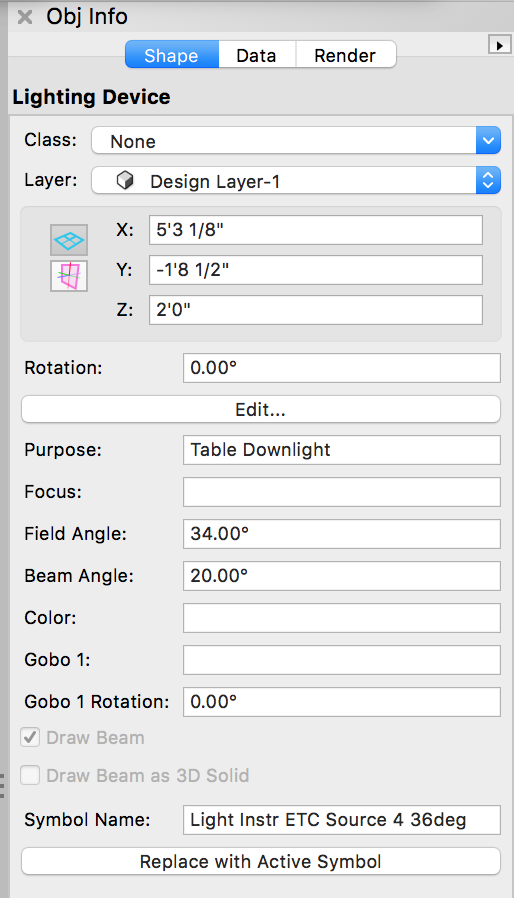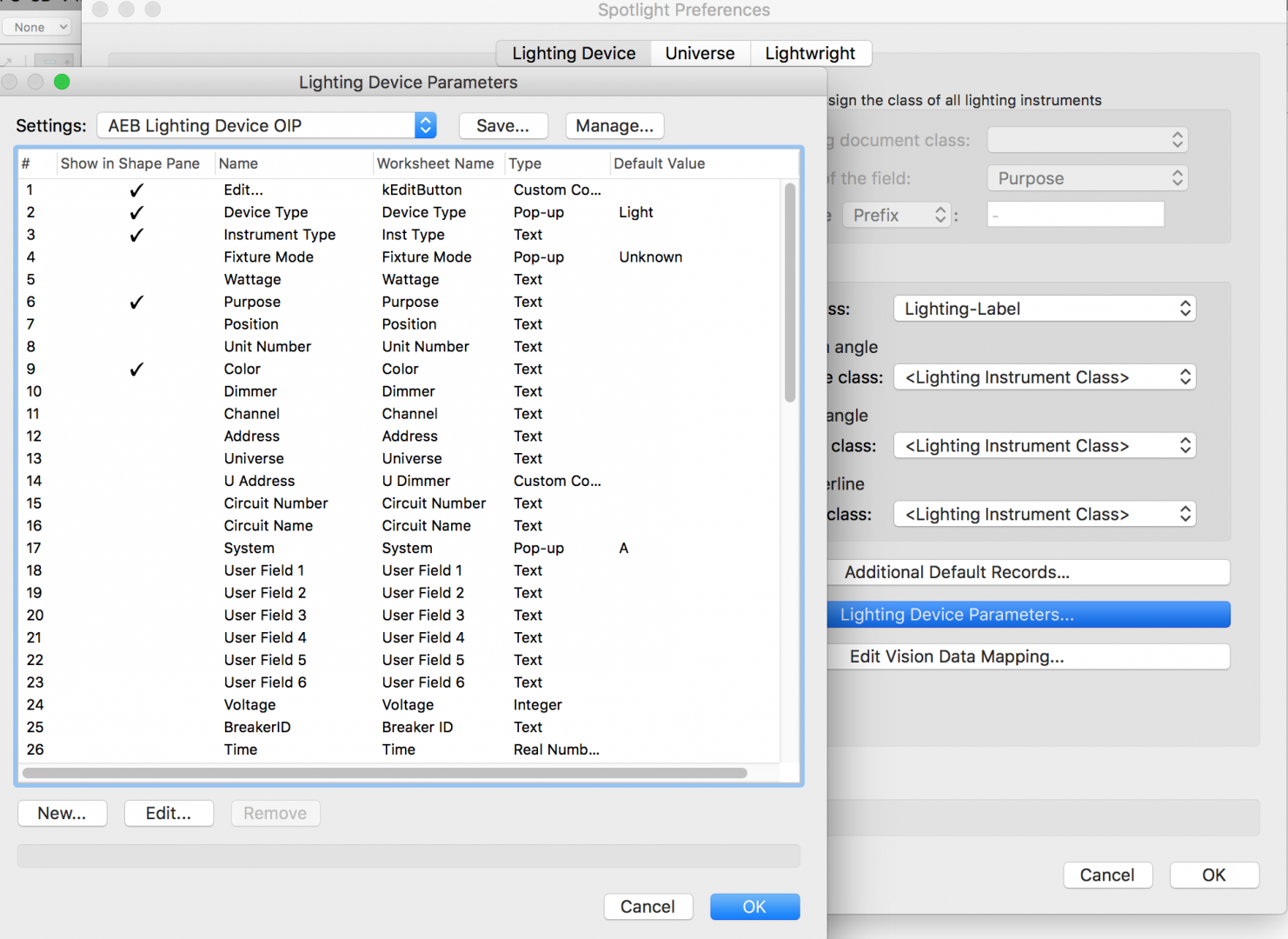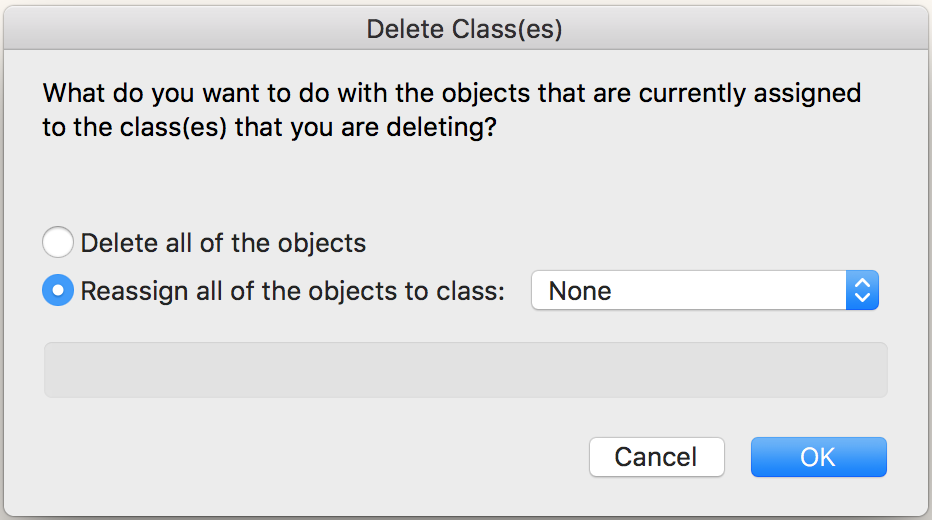-
Posts
3,173 -
Joined
-
Last visited
Content Type
Profiles
Forums
Events
Articles
Marionette
Store
Everything posted by Andy Broomell
-

Your opinion on greatly needed improvement in Spotlight.
Andy Broomell replied to FabK's question in Wishlist - Feature and Content Requests
Tangential thought: It's an odd thing to teach to students - the shortcomings of the various lighting objects and all the workarounds.... and how there are two different flavors of lights (Renderworks Lights vs Spotlight Devices) and how Spotlight Devices actually have Renderworks Lights "inside" of them but you don't actually have access to all of the Renderworks Light's parameters (unless you happen to know that when you right click the light in the Visualization Palette and select "Edit" it takes you to the embedded Renderworks Light). Et cetera, et cetera. Vectorworks newcomers are quick to point out how convoluted it can be, and they're not wrong. Once you learn the idiosyncrasies of how VW thinks, THEN you can start creating beautiful renderings. -

Your opinion on greatly needed improvement in Spotlight.
Andy Broomell replied to FabK's question in Wishlist - Feature and Content Requests
Between the channel/purpose naming system for Spotlight Lighting Devices and being able to name Renderworks Lights via the "name" field at the bottom of the OIP (or at the top of the Data tab in older versions), everything in the Visualization palette should be name-able, unless I'm missing something. I use a mix of Renderworks Lights and Spotlight Lighting Devices as well... Usually Renderworks Lights mainly, with Spotlight Lighting Devices being reserved for working with gobos, for using Focus Points (when convenient), or for when ellipsoidal beam angles are needed. -
YES. This is perfect. Definitely adding this as a command to my workspace. Thank you thank you!
-

Your opinion on greatly needed improvement in Spotlight.
Andy Broomell replied to FabK's question in Wishlist - Feature and Content Requests
I agree with everything stated above. Especially as a designer of scenery who also does lit renderings of designs, I need just a little bit more control over lighting without needing to delve into something like Vision (since I'm not programming) or Cinema4D. One small note which might be helpful - VW will insert the contents of the "Channel" and "Purpose" parameters from the Light Device's OIP into the name, before the numbers, which can help with naming and organizing your lights. To illustrate, I just typed in the words 'channel' and 'purpose' into the respective fields: I personally just use the Purpose field to name Lighting Devices. Also, since I don't create lighting plots and don't need most of the Lighting Device parameters that are available, I simplified the OIP by going to File<Document Settings<Spotlight Preferences<Lighting Device Parameters and adjusting to my liking: -
Cool, thanks! This gets me by for now. One thing I noticed is that it doesn't seem to work when the Symbols are inside of another Symbol, even if you're inside the parent Symbol editing mode. (In this case I have a bunch of bolt heads on an metal industrial door; the bolt symbols are inside of the door symbol. All 2D.) If I copy out the boltheads to the top level, run the script, then paste back into the door symbol it works fine. For future use, is there a way to alter the script so that it affects selected objects rather than operating by symbol name? That way you could: Perform the operation on multiple different symbol definitions at once. Perform the operation on some but not all of a particular symbol. Run the script without having to go inside the script and specify the symbol name beforehand. Include non-symbol objects such as rectangles, polygons, etc. I wish I knew scripting, but not yet, unfortunately...
-

Twinmotion Plugin + Sync
Andy Broomell replied to Tom Klaber's question in Wishlist - Feature and Content Requests
THIS baffles me. Amazing. -
Is there a way to select a large number of objects and rotate each of them around their respective center points by a random amount? Perhaps via scripting (@PatStanford) I have many instances of a Symbol arranged in a grid, but I'd like each instance to be rotated randomly for a more natural look. It'd be great to be able to select them and simply run a command.
-

Cant delete an auto generated class?
Andy Broomell replied to Garden_Guy's topic in General Discussion
That might be part of the issue. Never delete the None class, as many tools and internal components of Vectorworks rely on it. I'm surprised it even let you delete it; when I try it says "Cannot delete class 'None'." Generally I'd consider the None and Dimension classes as untouchable. They are the default classes that exist in every file, and even if you don't actively use them they should exist anyways. -

Cant delete an auto generated class?
Andy Broomell replied to Garden_Guy's topic in General Discussion
-

Twinmotion Plugin + Sync
Andy Broomell replied to Tom Klaber's question in Wishlist - Feature and Content Requests
Well, I'm sold! -
I've always hated this! I wish there was a way to make it render lines behind objects whose transparencies are below a certain threshold.
-

"X" displayed on windows and doors
Andy Broomell replied to Matt Brown's topic in General Discussion
I'm pretty sure that if it's part of a Door object, you can't directly Force Select the Loci or any parts of the Door. Instead it just selects the entire Door object. -

Teaser Tuesday - Rendered Panoramas - Vectorworks 2018
Andy Broomell replied to PVA - Admin's topic in News You Need
This is perfect. I like that we have some control, but it's not so open-ended that I have to think too hard about proper settings or resolution. -

Teaser Tuesday - Rendered Panoramas - Vectorworks 2018
Andy Broomell replied to PVA - Admin's topic in News You Need
I'm assuming it should be fairly simple to export a jpeg panorama, then in Photoshop do some simple touch-ups such as adding lighting glows/halos? (I realize the overall image will look distorted, but basic touch-ups and enhancements shouldn't be too difficult). Then resave and bring into the viewer of your choice. Is there any control over resolution / compression when exporting panoramas? Or are they always consistent? -

Teaser Tuesday - Rendered Panoramas - Vectorworks 2018
Andy Broomell replied to PVA - Admin's topic in News You Need
I agree. With web view there's a certain level of skill in navigating, whereas a simple single-point panorama is much easier for any given end user to interact with. Plus I don't like giving too much control to the viewer to explore around. A lot of theatrical and television design is based on one or more specific points of view. Having control over these POVs is preferable over letting a viewer free-roam. I'm sure this varies by industry though. Plus the ability to RENDER the view and incorporate proper textures and lighting as you've designed them in VW is paramount (unlike WebView which doesn't look great IMO). -

"X" displayed on windows and doors
Andy Broomell replied to Matt Brown's topic in General Discussion
You can see what class is controlling the Loci by selecting a Door, clicking Settings, then in the 2D Visualization section looking at what the "2D Loci" are assigned to. If this class is turned off and is not active, then the Loci should not be visible. -
I don't believe so. "Automatic" plane seems to only be an in-the-moment temporary working plane. I've simply memorized the Shift-1 keyboard shortcut for the Set Working Plane tool so that it's quick and easy to set a working plane. Only takes half a second, really, and it retains itself unlike using Automatic Plane. Btw, I almost exclusively use the second mode of the Set Working Plane tool so it's just a single click.
-

Teaser Tuesday - Rendered Panoramas - Vectorworks 2018
Andy Broomell replied to PVA - Admin's topic in News You Need
This is great! We used to have the ability to export panoramas up through 2016, with the "Export Quicktime VR Panorama" command, but that was locked into a Quicktime format whereas this new functionality seems to allow greater functionality in the end. I like that you can just get the jpeg if you want, which was previously difficult, if not impossible, to extract. Out of curiosity, was this new function built on the previous command's technology or was this something implemented from scratch? Also, are you able to control the initial view of the panorama? -

"X" displayed on windows and doors
Andy Broomell replied to Matt Brown's topic in General Discussion
Also, FYI, locus points don't print and never get exported to PDFs. Locus points are simply points in space (X,Y) and are indicated in Vectorworks with the X glyph. You can add your own with the 2D Locus tool (hotkey "0" zero). There is also a 3D Locus tool which incorporates Z coordinates as well. -
Perfect - thank you guys!
-
Does anyone happen to have a 3D model of wagon brake to share? I can make one easy enough but I figured I'd ask around first. Thanks!
-

Symbol Preview Pane request
Andy Broomell replied to michaelk's question in Wishlist - Feature and Content Requests
Yes! There is a LOT of potential usefulness yet to be implemented in the preview pane, not only for Symbols but for Textures and other resources as well. The space is there, so make it functional! -
Using the Replace Symbol command only replaces selected objects, by design. If you want to replace ALL of a particular Symbol with another, then go to the RM and delete the Symbol's definition, upon which you'll be prompted whether you want to delete all of the instances or replace them all with another Symbol. (This of course deletes the Symbol definition, so make sure you have it elsewhere if it's something you'll want again.) Regarding the location, it's all relative to the Symbols' insertion points. The 0,0 of the new Symbol is aligned with the 0,0 of the existing Symbol, so if the replacement process appears to "move" the objects, check that their Insertion Points are set up the same way.
-
I think you have to import it into the document first, separately. This a great example of a time when the new Resource Manager interface should have been / should be incorporated into an existing function. Wishlist it!
-

Teaser Tuesday - Multiple Drawing Views - Vectorworks 2018
Andy Broomell replied to PVA - Admin's topic in News You Need
Thanks @JimW for taking the time to make these videos and answer questions! If only I could have the multi-pane interface TODAY . I happen to have just started a project which requires modeling some WWII aircraft in 3D... some of the complex curves would be much easier to work on with multiple views!








